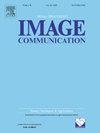Bayesian framework based additive intrinsic components optimization deformable model for image segmentation
IF 2.7
3区 工程技术
Q2 ENGINEERING, ELECTRICAL & ELECTRONIC
引用次数: 0
Abstract
The effectiveness of image segmentation can be greatly compromised by factors like inhomogeneity, low-resolution, and noise. Aiming at these challenges, we propose a new segmentation-oriented additive decomposition model for images. Firstly, the model assumes that the to be segmented image is the sum of three components: true image, bias field, and noise. Secondly, we pursue the true image in the image domain base on Bayesian framework, and establish the active contour model. In this model, the conditional probability is assumed to follow a local Gaussian distribution. The prior probability is constructed jointly by the following three assumptions. Specifically, we describe the true image as a Markov field defined as the Gibbs energy function. The bias field is modeled as a Gaussian distribution with mean 0 and variance . In addition, as an alternative, we employ regularization to the evolution curve by means of heat kernel convolution function. Finally, the proposed multi-objective optimization model is solved numerically using variational and gradient descent algorithms. The effectiveness of the proposed model has been validated through experiments conducted on various images, including natural, degraded text document, and others. The results show that compared to the classical active contour model, our model improve across four evaluation metrics. Among these, the smallest increase is in the P value, at 5%, while the most significant improvement is in the JSC value, reaching 14%.
基于贝叶斯框架的可加性内禀分量优化变形图像分割模型
图像分割的有效性可能会受到诸如不均匀性、低分辨率和噪声等因素的极大影响。针对这些挑战,我们提出了一种新的面向分割的图像加性分解模型。首先,该模型假设待分割图像是真实图像、偏置场和噪声三个分量的和。其次,基于贝叶斯框架在图像域内对真实图像进行追踪,建立活动轮廓模型;在该模型中,假设条件概率服从局部高斯分布。先验概率由以下三个假设共同构造。具体地说,我们将真像描述为定义为吉布斯能量函数的马尔可夫场。偏置场b是一个均值为0,方差为σi的高斯分布。此外,我们还利用热核卷积函数对演化曲线进行正则化。最后,采用变分算法和梯度下降算法对多目标优化模型进行数值求解。通过对各种图像(包括自然图像、降级文本文档等)进行的实验,验证了所提出模型的有效性。结果表明,与经典的活动轮廓模型相比,我们的模型在四个评价指标上都有改进。其中,P值的增幅最小,为5%,而JSC值的增幅最大,达到14%。
本文章由计算机程序翻译,如有差异,请以英文原文为准。
求助全文
约1分钟内获得全文
求助全文
来源期刊

Signal Processing-Image Communication
工程技术-工程:电子与电气
CiteScore
8.40
自引率
2.90%
发文量
138
审稿时长
5.2 months
期刊介绍:
Signal Processing: Image Communication is an international journal for the development of the theory and practice of image communication. Its primary objectives are the following:
To present a forum for the advancement of theory and practice of image communication.
To stimulate cross-fertilization between areas similar in nature which have traditionally been separated, for example, various aspects of visual communications and information systems.
To contribute to a rapid information exchange between the industrial and academic environments.
The editorial policy and the technical content of the journal are the responsibility of the Editor-in-Chief, the Area Editors and the Advisory Editors. The Journal is self-supporting from subscription income and contains a minimum amount of advertisements. Advertisements are subject to the prior approval of the Editor-in-Chief. The journal welcomes contributions from every country in the world.
Signal Processing: Image Communication publishes articles relating to aspects of the design, implementation and use of image communication systems. The journal features original research work, tutorial and review articles, and accounts of practical developments.
Subjects of interest include image/video coding, 3D video representations and compression, 3D graphics and animation compression, HDTV and 3DTV systems, video adaptation, video over IP, peer-to-peer video networking, interactive visual communication, multi-user video conferencing, wireless video broadcasting and communication, visual surveillance, 2D and 3D image/video quality measures, pre/post processing, video restoration and super-resolution, multi-camera video analysis, motion analysis, content-based image/video indexing and retrieval, face and gesture processing, video synthesis, 2D and 3D image/video acquisition and display technologies, architectures for image/video processing and communication.
 求助内容:
求助内容: 应助结果提醒方式:
应助结果提醒方式:


